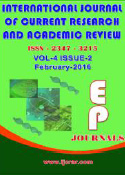Abstract Volume:4 Issue-2 Year-2016 Original Research Articles
 |
Online ISSN : 2347 - 3215 Issues : 12 per year Publisher : Excellent Publishers Email : editorijcret@gmail.com |
Our recent studies have shown that to investigate the ultrasonographic evaluation of peripheral nerves in diabetic and it`s correlation with nerve conduction. All nerve conductions in more than one limb indicates generalized diseased nerves, or generalized peripheral neuropathy. People with often develop generalized peripheral neuropathy. Twenty eight with type 2 diabetes (mean ± SD, 58.2 ± 6.7 years) and Twenty fifth healthy volunteers (mean, 57.48 ± 5.62 years) were enrolled in this study The cross-sectional area (CSA) and echo intensity of the peripheral nerve were evaluated at the carpal tunnel and proximal to the wrist (wrist) of the median nerve and in the tibial nerve at the ankle.There was a significant increase in the CSA and hypoechoic area of the nerve in diabetic patients compared with controls (wrist, 6.8 ± 1.2 mm2, 60.1% ± 6.0%; ankle, 8.7 ± 1.3% mm2, 54.6% ± 3.2%; and wrist, 8.9 ± 2.8 mm2, 70.2% ± 7.1%; ankle, 14.0 ± 5.9 mm2, 60.1% ± 6.1% in controls and diabetic patients, respectively; P < .05). Cross-sectional areas were negatively correlated with reduced motor nerve conduction velocity and delayed latency. These results suggest that sonographic examinations are useful for the diagnosis of diabetic neuropathy.
How to cite this article:
Varadharaju, B., 2016. Ultrasonographic evaluation of peripheral nerves in Diabetic and it`s correlation with nerve conduction.Int.J.Curr.Res.Aca.Rev. 4(2): 340-348doi: http://dx.doi.org/10.20546/ijcrar.2016.402.037



Quick Navigation
- Print Article
- Full Text PDF
- How to Cite this Article
- on Google
- on Google Scholor
- Citation Alert By Google Scholar
